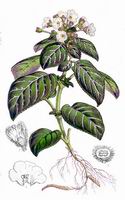
Bot. Mag. t. 4282 (1847)
Full name and orig. publication: Phinaea Benth. in Benth & Hook.f., Gen. pl. 2: 997 (May 1876).
Etymology: The name is an anagram of Niphaea.
Synonyms: -
Infrafamilial position: Gesnerioid Gesneriaceae (Gesnerioideae) - Gloxinieae.
Description:Terrestrial, perennial herbs with scaly rhizomes. Stem short, erect. Leaves opposite, (sub)equal, often congested at the stem apex, membranous, soft. Axillary cymes 1- to many-flowered, congested. Calyx campanulate, with spreading equal or subequal lobes. Corolla subrotate or cup-shaped, tube short, limb of spreading or erect, broad, subequal lobes. Stamens 4, adnate to base of corolla tube, staminode short; filaments slender, longer than the anthers, those of the anterior stamen pair longer and curved, anthers obovate to subglobose, with distinct (not confluent) cells, dehiscing by a short slit. Nectary absent. Ovary semi-inferior, style curved; stigma stomatomorphic. Fruit a somewhat fleshy or dry 2-valved capsule, opening loculicidally.
Chromosome number: 2n = 26 (P. multiflora).
Species number: 2(-3)
Species names (incl. publication and synonyms): See Skog, L.E. & J.K. Boggan. 2005: World checklist of Gesneriaceae: http://persoon.si.edu/Gesneriaceae/Checklist.
Type species: Phinaea albolineata (Hook.f.) Benth. ex Hemsl.
Distribution: Mexico (P. multiflora), northern S America (P. albolineata), [Cuba and Haiti (P. pulchella)].
Ecology: Terrestrial herb growing in forests, seasonally dormant.
Notes: Essentially based on molecular evidence (Smith et al. 2004, Roalson et al. 2005a,b), Phinaea was recently taxonomically redefined and reduced to 3 species, while the remaining species were included in the re-established genus Amalophyllon (Boggan, Skog & Roalson 2008). Recently, P. pulchella was recollected in Cuba and shown to be misplaced in Phinaea; it probably represents a new genus (Clark et al., in press). Thus the two core species of Phinaea are P. albolinetata (Hook.f.) Benth. ex Hemsl. and P. multiflora C.V.Morton. In habit and flower characters Phinaea and Amalophyllon are very similar. For the differences see under the latter genus. For the differences to Niphaea, a third genus very similar in habit and floral form, see under that genus.
Selected references: Skog, Ann. Missouri Bot. Gard. 65: 973-976 (1979), reg. rev. (Panama); Skog, Monogr. Syst. Bot. Missouri Bot. Gard. 85: 1114-1128 (2001), reg. rev. (Nicaragua), Wiehler, Gloxinian 52/3: 33-37 (2002), gen. inf.; Smith, Draper, Hileman, Baum, Syst. Bot. 29: 947-958 (2004); Roalson, Boggan, Skog, Zimmer, Taxon 54(2): 389-410 (2005a), molec. syst.; Roalson, Boggan, Skog, Selbyana 25(2): 225-238 (2005b), tax., Boggan, Skog & Roalson, Selbyana 29(2): 157–176 (2008); Clark et al., Syst. Bot. (in press).
Bibliography: See Skog, L.E. & J.K. Boggan. 2005. Bibliography of the Gesneriaceae. 2nd edition: http://persoon.si.edu/Gesneriaceae/Bibliography.
Illustrations:

|
Phinaea albolineata (Hook.) Benth. ex Hemsl., type species
Bot. Mag. t. 4282 (1847) |
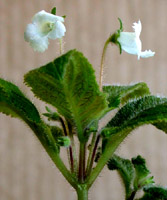 |
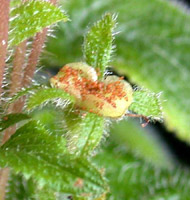 |
Phinaea aff. albolineata (Hook.) Benth. ex Hemsl.
Cult. Smithsonian Institution, orogin probably Brazil, phot. J.K. Boggan |
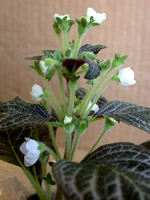 |
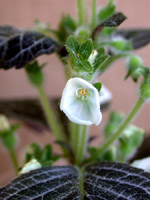 |
Phinaea
multiflora Morton
Cult. Smithsonian Institution, probably from Mexico, phot. J.K. Boggan |
last modified: 2007-01-05